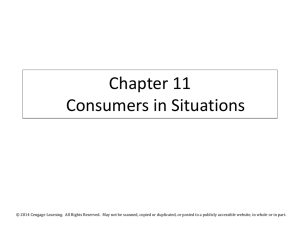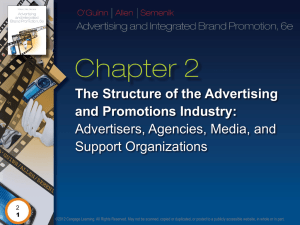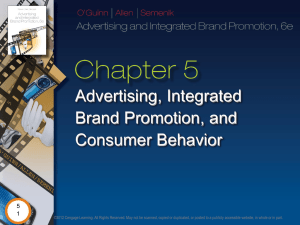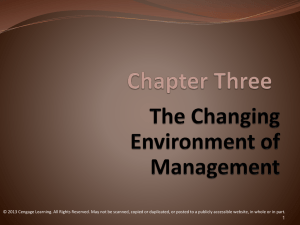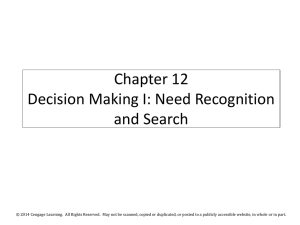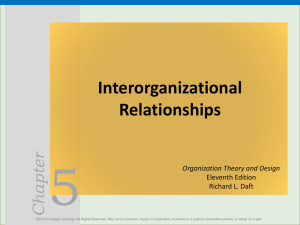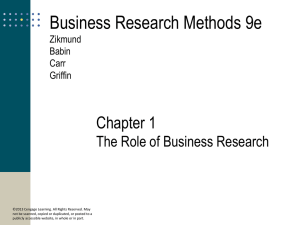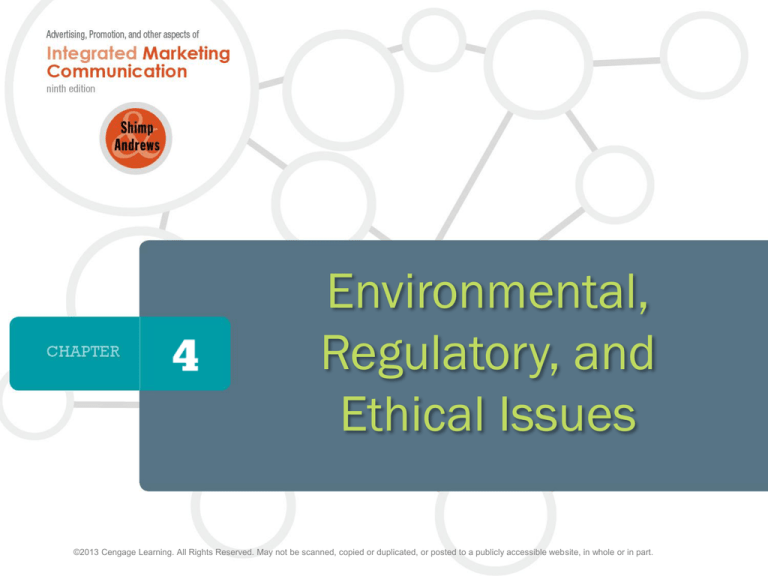
1
Environmental,
Regulatory, and
Ethical Issues
©2013 Cengage Learning. All Rights Reserved. May not be scanned, copied or duplicated, or posted to a publicly accessible website, in whole or in part.
Chapter Objectives
After reading this chapter you should be able to:
1. Appreciate the role of marketing communications
in environmental (green) marketing and
sustainability.
2. Recognize the principles that apply to all green
marcom efforts.
3. Explain the role and importance of government
efforts to regulate marketing communications.
4. Be familiar with deceptive advertising and the
elements that guide the determination of whether a
particular advertisement is deceptive.
©2013 Cengage Learning. All Rights Reserved. May not be scanned, copied or duplicated, or posted to a publicly accessible website, in whole or in part.
2
Chapter Objectives (cont’d)
5. Be acquainted with regulation of unfair business
practices and the major areas where the unfairness
doctrine is applied.
6. Know the process of advertising self-regulation.
7. Appreciate the ethical issues associated with
advertising, sales promotion, and other marcom
practices.
8. Understand why the targeting of marketing
communications toward vulnerable groups is a
heatedly debated practice.
©2013 Cengage Learning. All Rights Reserved. May not be scanned, copied or duplicated, or posted to a publicly accessible website, in whole or in part.
3
FDA’s Proposed Graphic Visual Health
Warnings on Cigarette Packages
©2013 Cengage Learning. All Rights Reserved. May not be scanned, copied or duplicated, or posted to a publicly accessible website, in whole or in part.
4
“Green” Product: Nissan Leaf
©2013 Cengage Learning. All Rights Reserved. May not be scanned, copied or duplicated, or posted to a publicly accessible website, in whole or in part.
5
Industry Responses to Environmental Problems
Green Advertising
Packaging Responses
Seal-of-Approval Programs
Cause-Oriented Programs
Point-of-Purchase
©2013 Cengage Learning. All Rights Reserved. May not be scanned, copied or duplicated, or posted to a publicly accessible website, in whole or in part.
6
Figure 4.1: Green Advertising Addressing the
Biophysical Environment
©2013 Cengage Learning. All Rights Reserved. May not be scanned, copied or duplicated, or posted to a publicly accessible website, in whole or in part.
7
Figure 4.2: Green Advertising Promoting a
Green Lifestyle
©2013 Cengage Learning. All Rights Reserved. May not be scanned, copied or duplicated, or posted to a publicly accessible website, in whole or in part.
8
Figure 4.3: Green Advertising Presenting an
Image of Environmental Responsibility
©2013 Cengage Learning. All Rights Reserved. May not be scanned, copied or duplicated, or posted to a publicly accessible website, in whole or in part.
9
Industry Responses to Environmental Problems
Green Advertising
Packaging Responses
Seal-of-Approval Programs
Cause-Oriented Programs
Point-of-Purchase Programs
©2013 Cengage Learning. All Rights Reserved. May not be scanned, copied or duplicated, or posted to a publicly accessible website, in whole or in part.
10
Packaging Responses
• Recyclable bottles
• Polystyrene to paperboard
• Plastic to cardboard
• Smaller packages
©2013 Cengage Learning. All Rights Reserved. May not be scanned, copied or duplicated, or posted to a publicly accessible website, in whole or in part.
11
Industry Responses to Environmental Problems
Green Advertising
Packaging Responses
Seal-of-Approval Programs
Cause-Oriented Programs
Point-of-Purchase Programs
©2013 Cengage Learning. All Rights Reserved. May not be scanned, copied or duplicated, or posted to a publicly accessible website, in whole or in part.
12
Seal-of-Approval Programs
• Designed to assist consumers in
identifying environmentally-friendly
products and brands
• Green Seal of Approval and Germany’s
Blue Angel
• 100% Recycled Paperboard
©2013 Cengage Learning. All Rights Reserved. May not be scanned, copied or duplicated, or posted to a publicly accessible website, in whole or in part.
13
Industry Responses to Environmental Problems
Green Advertising
Packaging Responses
Seal-of-Approval Programs
Cause-Oriented Programs
Point-of-Purchase Prorgams
©2013 Cengage Learning. All Rights Reserved. May not be scanned, copied or duplicated, or posted to a publicly accessible website, in whole or in part.
14
Industry Responses to Environmental Problems
Green Advertising
Packaging Responses
Seal-of-Approval Programs
Cause-Oriented Programs
Point-of-Purchase Programs
©2013 Cengage Learning. All Rights Reserved. May not be scanned, copied or duplicated, or posted to a publicly accessible website, in whole or in part.
15
Point-of-Purchase Programs
• Closer consultations with retailers about
POP needs:
• Fewer unused and discarded displays
• More permanent displays
• Less trash in landfills and billions of dollars
saved
©2013 Cengage Learning. All Rights Reserved. May not be scanned, copied or duplicated, or posted to a publicly accessible website, in whole or in part.
16
Industry Response: Manufacturer Waste
Options
1.
2.
3.
4.
Recycling
Incineration
Source Reduction
Landfills
©2013 Cengage Learning. All Rights Reserved. May not be scanned, copied or duplicated, or posted to a publicly accessible website, in whole or in part.
17
Appropriate Environmental Claims
Green Report: National Association of Attorneys General
www.naag.org
Make specific claims
Reflect current disposal options
Make substantive claims
Make supportable claims
©2013 Cengage Learning. All Rights Reserved. May not be scanned, copied or duplicated, or posted to a publicly accessible website, in whole or in part.
18
Guidelines for Green Marketing
Federal Trade Commission (FTC)
The U.S. government agency that has primary
responsibility for regulating matters such as
deceptive and unfair business practices.
©2013 Cengage Learning. All Rights Reserved. May not be scanned, copied or duplicated, or posted to a publicly accessible website, in whole or in part.
19
FTC Green Guides (7/28/92): General Principles
• Qualifications and disclosures should be
clear and prominent.
• Qualification/ application of claim issues
• Not overstate benefit
• Comparative claims and basis
©2013 Cengage Learning. All Rights Reserved. May not be scanned, copied or duplicated, or posted to a publicly accessible website, in whole or in part.
20
FTC Green Guides (7/28/92): Specific Example Areas
• General environmental benefits
• Degradable/ biodegradable/ photodegradable
• Compostable
• Recyclable
• Recycled content
• Source Reduction
• Refillable
• Ozone safe and ozone friendly
• What has not been addressed?? Updates to
Guides?
©2013 Cengage Learning. All Rights Reserved. May not be scanned, copied or duplicated, or posted to a publicly accessible website, in whole or in part.
21
Why Regulate Business??
• Regulation of Competition (e.g., FTC, DOJ)
• Regulation of Marketing Communications
• Federal Regulation (e.g., primarily FTC, FDA)
• Lanham Act (companies suing one another in federal court over false claims)
• State Regulation (e.g., NAAG, state attorney generals)
• Self-Regulation (e.g., ASRC: NAD, NARB, CARU)
Advertising Self Regulatory Council: National Advertising Division,
The National Advertising Review Board, Children’s Advertising Review Unit
• Primary FTC Marketing Communications Coverage: all
promotion/advertising claims; all environmental claims/packaging; online
marketing claims
• Primary FDA Marketing Communications Coverage: all package claims
and labeling; all prescription drug claims/ packaging
©2013 Cengage Learning. All Rights Reserved. May not be scanned, copied or duplicated, or posted to a publicly accessible website, in whole or in part.
22
Benefits of Regulation
• Consumer choice improved through
information
• Product quality tends to improve
• Reduced prices
©2013 Cengage Learning. All Rights Reserved. May not be scanned, copied or duplicated, or posted to a publicly accessible website, in whole or in part.
23
Costs of Regulation
• Cost of complying
• Enforcement costs
• Unintended side effects
©2013 Cengage Learning. All Rights Reserved. May not be scanned, copied or duplicated, or posted to a publicly accessible website, in whole or in part.
24
FTC Organizational Chart
5 FTC Commissioners
Bureau of Consumer Protection
Bureau of
Economics
Ad Practices
Marketing Practices
Bureau of
Competition
Financial Practices
Enforcement
Planning and Information
©2013 Cengage Learning. All Rights Reserved. May not be scanned, copied or duplicated, or posted to a publicly accessible website, in whole or in part.
25
FTC Regulatory Authority on Marketing
Communications
Federal Trade
Commission (FTC)
Regulatory Authority
Deceptive
Advertising
Unfair
Practices
Information
Regulation
©2013 Cengage Learning. All Rights Reserved. May not be scanned, copied or duplicated, or posted to a publicly accessible website, in whole or in part.
26
1983 FTC Deception Policy Statement
• Misleading. There must be a representation,
omission, or practice likely to mislead the consumer.
A misrepresentation is defined by the FTC as an
express or implied statement contrary to fact.
• Reasonable consumer. The act or practice must be
considered from the perspective of the “reasonable
consumer.”
• Material. The representation, omission, or practice
must be “material,” involving a central characteristic
of the product important to consumers and likely to
influence their choice or conduct regarding a product.
©2013 Cengage Learning. All Rights Reserved. May not be scanned, copied or duplicated, or posted to a publicly accessible website, in whole or in part.
27
Kraft Case History: FTC Deception Case
Example
• 1983: Campaign developed by JWT
and Kraft due to market share losses
• 1985-1987: Campaign
• Oct. 1985: CSPI complained
• 1987: FTC issued complaint
• 1989: ALJ initial decision
• 1991: Commission decision
• 1992: 7th Circuit denied appeal
(affirmed)
• 1993: Supreme Court (cert. denied)
©2013 Cengage Learning. All Rights Reserved. May not be scanned, copied or duplicated, or posted to a publicly accessible website, in whole or in part.
28
Kraft’s Appeal of ALJ’s Initial Decision and
Order
1. Commission must rely on extrinsic
evidence for implied claims
2. ALJ erred in finding consumers took
misleading claims
3. Calcium immaterial
4. Order would be a restraint on free
speech (Ist Amendment)
©2013 Cengage Learning. All Rights Reserved. May not be scanned, copied or duplicated, or posted to a publicly accessible website, in whole or in part.
29
Kraft Materiality Question
• “How important are the following in your purchase decision
for Kraft individual cheese slices?”
• Results: “extremely important” or “very important”
• One through eight below above 50% agreement:
1. Good tasting
2. Made by a company you can trust
3. Real cheese flavor
4. Individually wrapped for freshness
5. Consistent quality
6. Convenient to use
7. Reasonably priced
8. A source of calcium
9. A source of Vitamin C
©2013 Cengage Learning. All Rights Reserved. May not be scanned, copied or duplicated, or posted to a publicly accessible website, in whole or in part.
30
Materiality is presumed when ...
(see 1983 FTC Deception Policy Statement, footnotes 47-58)
• Express claims
• Seller knowledge of false/omitted claim
• Health, safety, or other areas of concern (e.g.,
central characteristics of product)
• Purpose, safety, efficacy, or cost of product
• Durability, performance, warranties, or quality
• Finding of materiality by another agency (e.g.,
EPA)
©2013 Cengage Learning. All Rights Reserved. May not be scanned, copied or duplicated, or posted to a publicly accessible website, in whole or in part.
31
FTC Unfairness Definition (1994)
“... The act or practice (1) causes or is likely to cause substantial
injury (e.g., monetary, health/safety) to consumers, (2)
which is not reasonably avoidable by consumers themselves
and (3) not outweighed by countervailing benefits to
consumers or competition.”
•
Not whether the ad practice is immoral, unethical, offends
public policy...
Applications of Unfairness:
1. Basis for Advertising Substantiation
2. Children (and other vulnerable populations)
3. Trade Regulation Rules (as opposed to case by case actions)
©2013 Cengage Learning. All Rights Reserved. May not be scanned, copied or duplicated, or posted to a publicly accessible website, in whole or in part.
32
For Major Regulations/Unfairness:
• Central Hudson 4-part test to determine the validity of
the regulation of commercial speech
(All four must be met to regulate)
1. The speech must concern lawful activity and must not be
misleading (rules out deception) (Note: Does 1st Amendment
protect deceptive commercial speech??)
2. The government’s interest is substantial
3. The regulation directly advances the government’s interest.
4. The regulation is not more extensive than necessary to serve
its stated purpose
Central Hudson Gas and Electric Corporation v. Public Service Commission of New York, 447 US 557, 566 (1980)
44 Liquormart v. Rhode Island, 116 S.Ct. 1495, 1500 (1996)
©2013 Cengage Learning. All Rights Reserved. May not be scanned, copied or duplicated, or posted to a publicly accessible website, in whole or in part.
33
FTC Regulatory Process (deceptive advertising
and information regulation)
• IF company agrees to complaint and initial order: no
admission of guilt/order negotiation
• IF company does not agree: goes to trial and no order
negotiation if they lose
• Order Provision Options (remedies):
• cease and desist
• affirmative disclosure (triggered disclosure, corrective
advertising)
• consumer redress
• asset seizure (federal court)
©2013 Cengage Learning. All Rights Reserved. May not be scanned, copied or duplicated, or posted to a publicly accessible website, in whole or in part.
34
Information Regulation
Corrective Advertising
A firm that misleads consumers should
have to use future advertisements to
rectify any deceptive impressions it has
created in consumers’ minds
©2013 Cengage Learning. All Rights Reserved. May not be scanned, copied or duplicated, or posted to a publicly accessible website, in whole or in part.
35
Regulation of Product Labeling
• Food and Drug Administration (FDA)
• Responsible for regulating information on
the packages of food, drug, and tobacco
products
• Responsible for regulating ads for
prescription drugs
• Requires advertisers to present a balanced
perspective when advertising drugs
©2013 Cengage Learning. All Rights Reserved. May not be scanned, copied or duplicated, or posted to a publicly accessible website, in whole or in part.
36
Lanham Act and State Agencies’ Regulation
of Marketing Communications
• Lanham Act (companies suing one another in
federal court over false claims – must have extrinsic
evidence in the case of implied claims)
• Most, if not all, states have departments of consumer
affairs or consumer protection.
• The National Association of Attorneys General
(NAAG) – includes attorneys general from all 50
states (Note: major case – 1998 master settlement
agreement and restrictions with tobacco industry)
©2013 Cengage Learning. All Rights Reserved. May not be scanned, copied or duplicated, or posted to a publicly accessible website, in whole or in part.
37
Advertising Clearance Process
• Advertising Clearance Process
1. Advertising agency clearance
2. Approval from the advertiser’s legal
department and perhaps also from an
independent law firm
3. Media approval
©2013 Cengage Learning. All Rights Reserved. May not be scanned, copied or duplicated, or posted to a publicly accessible website, in whole or in part.
38
Advertising Self-Regulation
• Advertising Self-Regulatory Council (ASRC)
consists of three units:
• Council of Better Business Bureau’s National Advertising
Division (NAD)
• National Advertising Review Board (NARB)
• The Children’s Advertising Review Unit (CARU)
• Note: resolution process with company is voluntary.
©2013 Cengage Learning. All Rights Reserved. May not be scanned, copied or duplicated, or posted to a publicly accessible website, in whole or in part.
39
NAD/NARB Complaint Resolution Process
Complaint Screening and
Case Selection
Initial NAD
Evaluation
Advertiser’s Initial
Response
NAD’s Final
Evaluation
Advertiser’s Final
Response
©2013 Cengage Learning. All Rights Reserved. May not be scanned, copied or duplicated, or posted to a publicly accessible website, in whole or in part.
40
Ethical Issues in Marketing Communications
• Ethics in our context involves matters of
right and wrong, or moral, conduct
pertaining to any aspect of marketing
communications
©2013 Cengage Learning. All Rights Reserved. May not be scanned, copied or duplicated, or posted to a publicly accessible website, in whole or in part.
41
Ethics of Targeting to Children/ Teens and
Vulnerable Populations
• “Old Joe the Camel”/ RJR tobacco marketing
• Marketing violent entertainment to kids
• Food marketing practices and childhood obesity
©2013 Cengage Learning. All Rights Reserved. May not be scanned, copied or duplicated, or posted to a publicly accessible website, in whole or in part.
42
Sources of Ethical Issues
Targeting Marcom
Public Relations
Advertising
Ethical Issues in
Marketing Activities and
Communications
Packaging
Communications
Sales Promotions
Internet Marketing
©2013 Cengage Learning. All Rights Reserved. May not be scanned, copied or duplicated, or posted to a publicly accessible website, in whole or in part.
43
The Ethics of Targeting
• Ethical Debate
• Is it ethical to target products and communications
efforts to segments that vulnerable or put at risk by
these actions?
• Is Targeting Unethical or Just Good
Marketing?
• When does a good targeting strategy become a
method of unfair (unethical) advantage?
©2013 Cengage Learning. All Rights Reserved. May not be scanned, copied or duplicated, or posted to a publicly accessible website, in whole or in part.
44
Fostering Ethical Marketing Communications
(see also utilitarian rule; categorical imperative)
The Golden
Rule
Act in a way that you would want
others to act toward you
The
Professional
Ethics
Take only actions that would be
viewed as proper by an objective
panel of your professional
colleagues
The TV Test
“Would l feel comfortable
explaining this action on television
to the general public?”
©2013 Cengage Learning. All Rights Reserved. May not be scanned, copied or duplicated, or posted to a publicly accessible website, in whole or in part.
45


